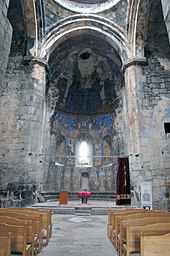Akhtala Monastery
The monastery Achtala ( Armenian Ախթալայի վանք Achtalaji Wank ) is a former convent of the Armenian Apostolic Church in the city Achtala in the province of Lori in the north of Armenia . It is currently (2004) vacant.
location
Akhtala Monastery is located approx. 210 km (driving distance) north of the capital Yerevan ; it was built as a fortified monastery on a raised rocky promontory surrounded on three sides by deep ravines.
Building description
On the mountain side, conical towers and walls protect the monastery. The walls and towers of the fortress were built from bluish basalt and lime mortar. The only access to the facility is on the north side. There is a three-story tower from the 13th century built into the fortress walls.
The most important building of the monastery is the Mother of God Church. The exact year of construction of the main church of the monastery is unknown. According to local tradition, the Byzantine Emperor Herakleios , who probably came from Armenia, had the church built in the 7th century. Another legend names the Georgian King Vakhtang I Gorgassali as the builder. Accordingly, the church was built in the fifth century. However, there is no scientifically accepted evidence for either tradition. Today the construction time of the church is generally dated to the 11th to 13th centuries. But it had a previous building. The building is a cross-domed church with a rectangular floor plan. On its east side it has a semicircular main apse and two two-story side apses. The long nave, divided by arches, has three aisles; originally it was covered by a large dome. This was damaged during the conquest of Armenia by Timur and completely demolished in 1784. In the 19th century, the viceroy of the Caucasus, Prince Mikhail Semjonowitsch Voronzow , had a hemispherical wooden dome covered with iron plates built instead of the original dome. This dome was renovated in Soviet times.
Next to its portico there is a small chapel in which, according to the tradition of the medieval historians Vardan Areveltsi and Kirakos Gandzaketsi, Prince Ivane and his son Avag are buried. The medieval wall paintings inside the church are among the best preserved in Armenia. They are dated from 1205 to 1276. The historian Bishop Stepanos Orbelian reported in the 13th century that the church had an important relic , namely that John the Baptist used to baptize Christ .
In the vicinity of the main church are the remains of a single-nave church from the 13th century, partially surrounded by a moat. The church had a semicircular apse on the east wall.
To the north of the church, the ruins of several monastery cells and other rooms as well as a two-story refectory , in which the fortress guards were probably also housed, have been preserved.
history
Akhtala Monastery was built at the end of the 10th century by the Kiurikids, a side branch of the Bagratids . They had the monastery built in a region that had been known for its ore deposits since the Bronze and Iron Ages . In the 1180s, the monastery came into the possession of the Zakarids, a princely dynasty who ruled as vassals of Georgian kings . Prince Ivane became the new ruler of Akhtala. While his brother Zakare remained loyal to the Armenian Apostolic Church, the prince converted to the Georgian Orthodox faith . As a result, he also had the monasteries in his domain in northern Armenia converted to Georgian Orthodox.
In 1763 the Georgian King Erekle II had around 800 Greek families resettled from Gümüşhane in the Ottoman Empire to Akhtala, where they were supposed to work in the nearby copper mines. They also took over the monastery they called Meramani . Inscriptions left by the miners from this period have been preserved on the monastery walls. In the 19th century the monastery came into the possession of the Armenian royal family Melikow.
Web links
See also
Individual evidence
- ↑ Masters, Tom, 1977-: Georgia, Armenia & Azerbaijan . 2nd ed. Lonely Planet Publications, Footscray, Vic. 2004, ISBN 1-74059-138-0 .
- ↑ a b c d Helix Consulting LLC: Akhtala 3: Complex - Akhtala - Armenian Heritage. Retrieved November 1, 2017 .
- ↑ Helix Consulting LLC: Akhtala 4: St. Astvatsatsin church - Akhtala - Armenian Heritage. Retrieved November 1, 2017 .
- ^ A b c Helix Consulting LLC: Akhtala 2: History - Akhtala - Armenian Heritage. Retrieved November 1, 2017 .
Coordinates: 41 ° 9 ′ 2.1 ″ N , 44 ° 45 ′ 50.1 ″ E



